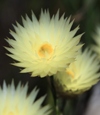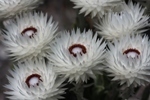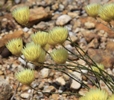Helichrysum
Annual or perennial herbs or shrublets with capitula solitary, in small groups or in tight clusters. Capitula are heterogamous disciform (or rarely homogamous discoid). Involucral bracts are generally colourful: white, yellow, red, pink, straw-coloured or brown. Flowers 2–2500. Female florets are yellow, pistillate, filiform, and are fewer than the disc florets. Disc florets perfect. Pappus bristles are generally in one row and not fused at the base. 585 species worldwide – mainly Africa & Madagascar, also Europe & Asia.Dolichothrix
Woody plants, stunted from growing in rock crevices. Leaves minute, scale-like, densely appressed, very densely glandular. Capitula solitary or 2–4 terminally on branches; 24–28-flowered. Involucral bracts milky white, reflexed in upper part. Florets yellow. Cypselas very densely hairy, with twin-hairs. Monotypic Western & Eastern Cape endemic.Distinguished from Helichrysum by its scale-like leaves and lack of female florets.
Edmondia
Perennial herbs or shrublets, sprawling, ascending or erect. Leaves ascending, erect or appressed, subulate to linear-lanceolate. Capitula large, broadly campanulate, mostly solitary. Involucral bracts white, pink or yellow, radiate, much exceeding the florets. Flowers 85–315. 3 species – endemic to Western Cape.Distinguished from Helichrysum by its xeromorphic, concave, adaxially tomentose leaves.
 |
||
| E. sesamoides | E. sesamoides | E. sesamoides |
Galeomma
Prostrate woolly annual herb. Capitula discoid or disciform, in terminal clusters embedded in wool of surrounding leaves. 2 species endemic to southern Africa.Distinguished from Helichrysum by its fenestrated stereome and very acute to acuminate involucral bracts, and by the female florets outnumbering the hermaphrodite florets.
thumb.jpg) |
thumb.jpg) |
| G. oculus-cati | G. oculus-cati |
Gnaphalium
Perennial or annual herbs. Branches never long and straggling. Capitula disciform, few together, terminal or racemosely arranged. Involucral bracts in few rows, light brown, cream or white; stereome undivided. Cypselas small, oblong, glabrous or sparsely hairy with twin-hairs. 80 species worldwide – cosmopolitan, 14 species in southern Africa.Distinguished from Helichrysum by its purple female florets, which outnumber the disc florets.
thunb.jpg) |
thumb.jpg) |
thumb.jpg) |
thumb.jpg) |
| G. capense | G. capense | G. limicola | G. limicola |
Helichrysopsis
Perennial herbs. Stems much branched, spreading, ashy grey, closely leafy. Capitula disciform, narrowly campanulate, few clustered at branchlet tips. Involucral bracts in 4 rows, outer short and pale brown, inner with tips milk-white, stereome undivided. Female florets outnumbering disc florets. Pappus bristles apically plumose, basally connate. Cypselas with globose, myxogenic twin-hairs. Monotypic – KZN and Mozambique coast.Distinguished from Helichrysum by its strongly revolute leaf margins and female florets outnumbering the disc florets.
Lasiopogon
Annual herbs, small, prostrate and woolly. Capitula disciform, campanulate, closely surrounded by leaves. Involucral bracts in 2 or 3 rows, whitish or straw-coloured. 8 species in southern Africa and rest of Africa, 1 species also in Spain & India.Distinguished from Helichrysum by its disciform capitula.
thumb.jpg) |
|
| L. micropoides | L. micropoides |
Phaenocoma
Rigid, erect shrubs. Branches covered in brachyblasts borne at right angles to the main branch; branches and brachyblasts densely covered in small, fleshy, knob-like leaves. Capitula large, with 800–1000 florets. Involucre bright pink but fading with age; lamina of involucral bracts up to 22 mm long. Monotypic Western Cape endemic.Distinguished from Helichrysum by its minute leaves, purple female and disc florets, and disc florets outnumbering the female florets.
thumb.jpg) |
thumb.jpg) |
|
| P. prolifera | P. prolifera | P. prolifera |
Pseudognaphalium
Annual, biennial or perennial herbs. Capitula disciform, in small clusters corymbosely or cymosely arranged. Involucral bracts in 3 or 4 rows, white, yellow or cream. 90 species in Africa, Asia, Europe and America – 3 widespread in southern Africa.Distinguished from Helichrysum by its disciform capitula, translucent involucral bracts and scabrid pappus bristles.
thumb.jpg) |
thumb.jpg) |
thumb.jpg) |
| P. oligandrum | P. oligandrum | P. oligandrum |
Syncarpha
Perennial shrubs. Leaves alternate, sessile. Capitula discoid, solitary or few together. Involucral bracts white, yellow, pink or brown. Pappus bristles fused at the base in a smooth ring, shaft usually plumose, rarely barbellate or smooth. 25 species – Western & Eastern Cape.Distinguished from Helichrysum by the homogamous and discoid capitula, pappus bristles that are connate in groups, undivided stereome, and myxogenic cypsela hairs.
 |
thumb.jpg) |
|
| S. chlorochysum | S. vestita | S. paniculata |
Tenrhynea
Shrubby perennial, branches loosely leafy. Leaves revolute, decurrent, glabrous above, white-tomentose below. Capitula disciform, cylindric, in small terminal clusters, often further aggregated into spreading corymbose panicles. Involucral bracts pink or white, in several rows, radiating. Receptacle paleate. Cypselas with scattered, short, clavate myxogenic hairs. Monotypic in eastern & northern parts of South Africa.Distinguished from Helichrysum by its paleate receptacle and narrow decurrent leaves.
thumb.jpg) |
thumb.jpg) |
|
| Tenrhynea sp. | Tenrhynea sp. | Tenrhynea sp. |
Troglophyton
Delicate annual or short-lived perennials with an effuse habit. Leaves small, on filiform petioles, both surfaces cobwebby or woolly. Capitula discoid or disciform, small, few, on filiform peduncles. 6 species endemic to southern Africa.Distinguished from Helichrysum by its purple female and disc florets.
| Troglophyton sp. |
Vellereophyton
Grey or white-woolly annual or weakly perennial grey-woolly herbs. Leaves small to medium-sized, oblanceolate or spathulate. Capitula up to 4 x 3 mm, disciform or discoid, very small, few or many, almost sessile in woolly glomerules. Involucral bracts with opaque white tips; pappus bristles subplumose in upper part. 7 species endemic to southern Africa. One species naturalised in Australia & New Zealand.Distinguished from Helichrysum by its purple female and disc florets.
thumb.jpg) |
thumb.jpg) |
|
| V. dealbatum | V. dealbatum | V. dealbatum |
thumb.jpg)
thumb.jpg)

thumb.jpg)
thumb.jpg)
thumb.jpg)
thumb.jpg)
thumb.jpg)
thumb.jpg)